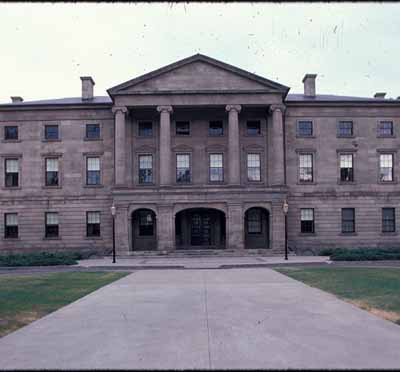Province House National Historic Site of Canada
Charlottetown, Prince Edward Island

General view
© Parks Canada Agency / Agence Parcs Canada
Address :
165 Richmond Street, Charlottetown, Prince Edward Island
Recognition Statute:
Historic Sites and Monuments Act (R.S.C., 1985, c. H-4)
Designation Date:
1966-10-26
Dates:
-
1839 to 1847
(Construction)
-
1864 to 1867
(Significant)
-
1974 to 1983
(Significant)
-
1847 to 1873
(Significant)
Event, Person, Organization:
-
Confederation, Charlottetown Conference
(Event)
-
Fathers of Confederation
(Person)
-
Legislature of Prince Edward Island
(Organization)
-
Isaac Smith
(Architect)
Other Name(s):
-
Province House
(Designation Name)
Research Report Number:
1950-054
DFRP Number:
56523 00
Plaque(s)
Existing plaque: 165 Richmond Street, Charlottetown, Prince Edward Island
Completed in 1847, this neo-classical building was designed and built by local architect Isaac Smith to accommodate the provincial legislature and administrative offices. It also housed the Island's Supreme Court until 1872. Province House retains its central role in Island public life, with the Assembly holding sessions here. In September 1864 it was the scene of the first conference on colonial union. Delegates from the colonies of Prince Edward Island, New Brunswick, Nova Scotia, and Canada met in the legislative council chamber, now the Confederation Chamber, to begin discussions which led to confederation in 1867.
Description of Historic Place
Province House National Historic Site of Canada is a large public building in the Neoclassical style which is situated in the centre of Charlottetown on Great George Street. It is the dominant feature of Queen Square and a landmark in the Great George Street Historic District.
Heritage Value
Province House National Historic Site has been designated for its historic and architectural significance to Canada because it is the site of the Charlottetown Conference of 1864, the first meeting that led to Canadian confederation in 1867, it is a fine example of the Neoclassical architectural style, it is representative of the judicial institution of Prince Edward Island, it forms one end of the Great George Street Historic District and remains an important component of Queen Square.
The heritage value of this site resides in its historical associations with Canadian Confederation and with the judicial system in Prince Edward Island as well as in its illustration of the Neoclassical style of architecture.
Province House was designed in 1839 by the premier Prince Edward Island architect/ builder of the period, Isaac Smith. It was completed for initiation as Prince Edward Island’s legislature on the 26 January, 1847. The main purpose of the building was to house a Legislative Assembly, found on the second storey. Province House also contains a Legislative Council on the second storey where the delegates to the Charlottetown Conference held their meetings in September 1864. From 1847 to 1872, Province House included space on the ground floor to accommodate the supreme court and judicial offices for the province of Prince Edward Island. Province House is owned by the Prince Edward Island government.
Queen Square is Charlottetown’s central square, set aside in the original layout of the town for administrative and church buildings. Province House occupies the central position in Queen Square framing Great George Street with a view of the waterfront.
The Confederation Chamber was refurbished to reflect its historical importance in 1920 and again from 1974-1983. At this time, the exterior of the building was returned to its 1850 condition, while the legislative council chamber (Confederation Chamber), library, and a series of administrative offices were restored to the 1864 period. The supreme court chamber on the ground floor was also returned to its original size.
Sources: HSMBC Minutes, May-June 1960, October 1966, June 1970, June 1980, November 1981, November 1990, June 1992.
Character-Defining Elements
Key elements that define the heritage character of this property include, for example:
the symmetrical three-storey massing of the building with its central section, balanced wings and shallow hipped roof, the balanced classical proportions of the exterior (its regular elevations, central portico, projecting wings and pilasters), the classical definition of the central entrance with a projecting portico containing a decorated pediment, and pillared upper elevation set on more substantial base composed of complementary (Roman) arches, the decorative use of pilasters and columns employing antique (Ionic) orders, the grey Nova Scotia freestone of the exterior with its fine quality of craftsmanship, the symmetrical design of the interior with its balanced wings and central staircase, the functional sub-division of the interior space (ground floor offices and restored Supreme Court facilities, second floor major public rooms associated with the legislature, upper storey offices) the original layout, architectural furnishings and early furniture of the Legislative Council (in particular the chairs and tables, members’ desks and chairs, and the speaker’s chair and canopy which existed at the time of the Charlottetown Conference), the materials and excellent early Island craftsmanship of the approximately 50 items of original furnishings of the building (including those in the Legislative Council listed above), its setting at the head of Queen’s Square flanked by other government buildings as a landmark at one end of the Great George Street Historic District, the building’s presence on the site of the Charlottetown Conference.